Who thinks about their RV step covers? They’re just steps, right? What’s the big deal? Well, in addition to the increased safety that good traction ensures, if you think about it, those step covers are all that’s standing between what’s outside your RV and what’s inside your RV.
Anyone who has followed us for any length of time at all knows that we strive to keep our motorhome looking and performing like it’s brand new. After all, we live, work, and travel in our rig full time. Second only to the great outdoors (our favorite living room), our RV is where we spend most of our time.
That and our appreciation for safety are why we’ve paid close attention to the crossover between the great outdoors and the interior of our home-on-wheels, our RV steps. It’s also why in today’s post, we’re talking about an oft-forgotten but essential piece of RV safety and housekeeping, high-quality step covers.
Are RV Step Covers Necessary?
Most RV steps come standard with some type of cover or traction material applied, but in truth, they often don’t offer much traction at all. RV steps can get slippery when they’re wet or when shoes are wet, so as always, safety is the number one reason for high-quality RV step covers.
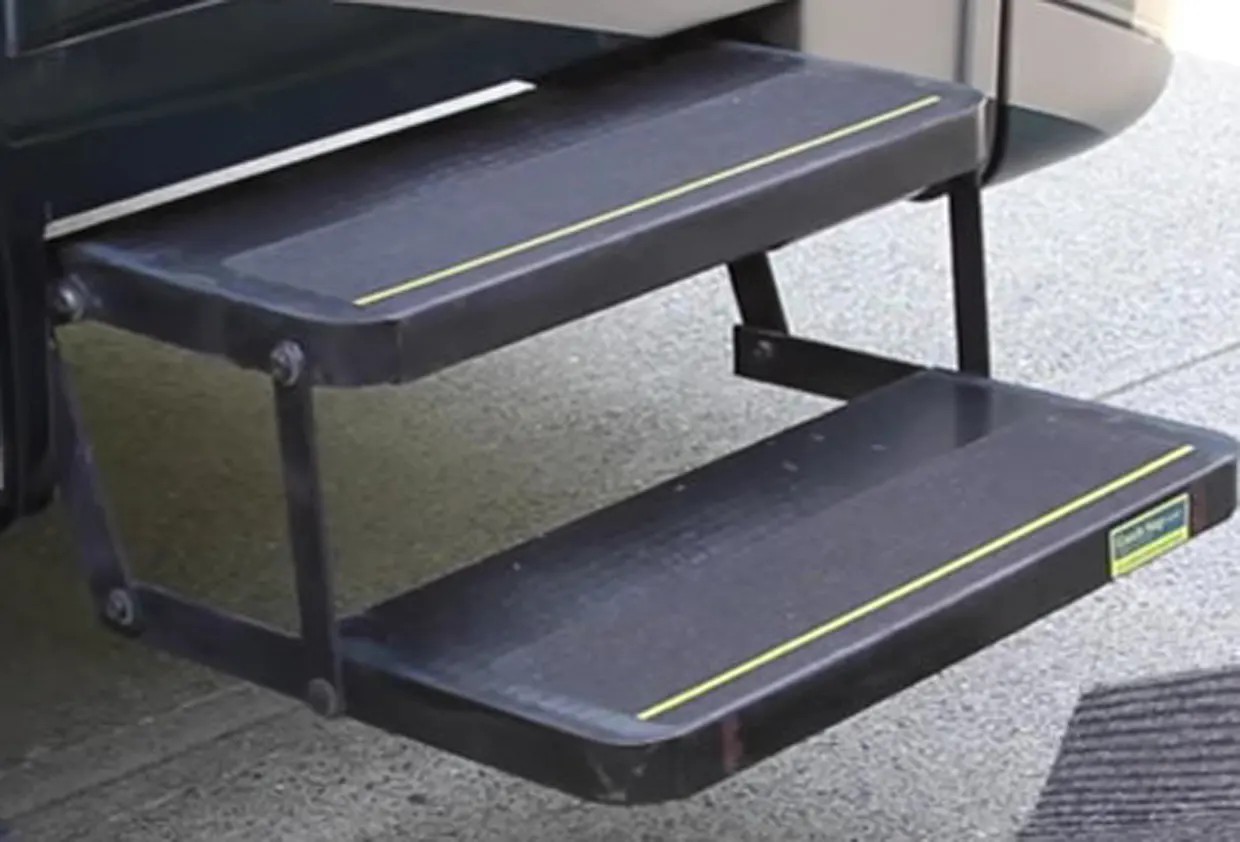
While most RV steps come with some sort of traction material or step cover, replacing them with a high-quality, durable cover is well worth the investment.
But in addition to safety, quality step covers provide a way to wipe your shoes of accumulated debris before you enter your RV.
We don’t wear street shoes inside our RV, but you’d be surprised what can be tracked into a living space just moving from outside to inside.
And finally, we’ve been at this for nearly two decades. We’ve lived in our RV for more than 18 years now, so we’ve got the inside scoop on a few things, and we’re here to tell you that yes, RV step covers are necessary.
Are All RV Step Covers About the Same?
No. From many years of experience, we can assure you that not all RV step covers are the same – or even close to the same.
When we started RVing, there was a lot we didn’t know. We bought the cheap step covers you see available in most camping stores and thought they’d be fine. Not only did they not serve the purpose well, but they also didn’t last. So in the end, they were a double fail. Wiping our shoes on that fake turf material was virtually useless – sort of like wiping your shoes on grass. And they fell apart within a year, so we had to replace them frequently, making them “cheap” in quality only!
What Are the Best RV Step Covers on the Market?
In our opinion, and based on our experience, Prest-O-Fit Ruggids are the best step covers available.
They’re very durable, they fit well, and they do a good job of cleaning your shoes while also providing excellent traction. In other words, they check all the boxes of a high-quality RV step cover.
Our Ruggids have lasted for as much as five years at a time.
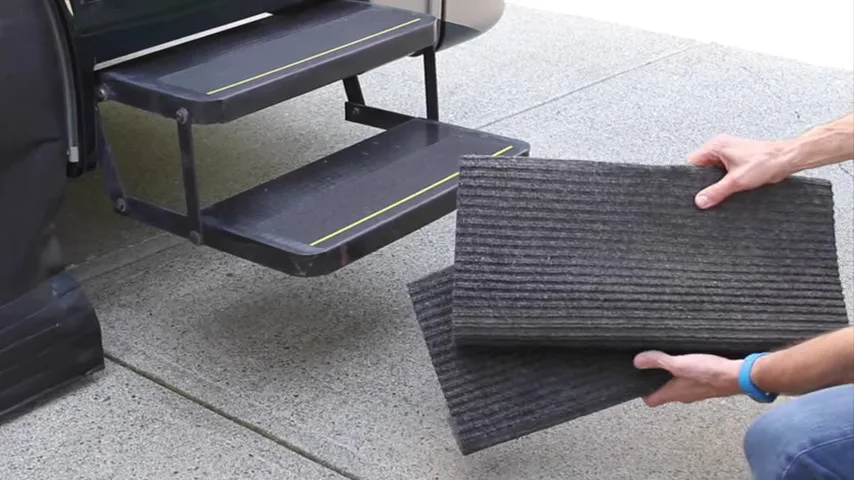
These Prest-O-Fit Ruggids lasted through five years of full-time, year-round RV living. Now that’s durability!
In fact, we recently bought a new set that we have in storage in our RV basement. Our current Ruggids step covers are old but still aren’t ready to be replaced. We like these step covers so much that we want to be sure to have a set on hand for when we need them – the ultimate compliment for a manufacturer of any product.
For our RV, we use the Prest-O-Fit Ruggids 23-inch Jumbo Wraparound Step Covers.
- Deep treads trap dirt at the door.
- Designed for straight steps.
Prest-O-Fit Ruggids are available in black, blue, and brown. As with any RV step cover, you’ll need to measure your RV step to know what size to buy.
Once you’ve taken your measurements, you can use this link to find the size and type of step cover you need for your RV.
How to Measure Your RV Steps for New Step Covers
It’s very easy to measure your RV steps for step covers. There are only two factors you’ll need to consider. You simply need to use your tape measure to grab the width of your RV step. Use your tape measure to measure your RV step from one inside edge to the other. Most RV steps are between 18 and 23 inches wide.
You’ll also need to note whether your RV steps are straight or curved. If your RV steps are curved, make sure to order covers that fit curved steps. Some covers fit only straight steps, but others fit straight OR curved steps.
Prest-O-Fit Ruggids RV step covers fit RV steps from 8 to 11 inches deep. The step cover will wrap around your RV step where the two ends will be joined under the step using heavy-duty zip ties.
Installation is an easy DIY job. Let’s have a look at the step-by-step process.
How to Install New RV Step Covers
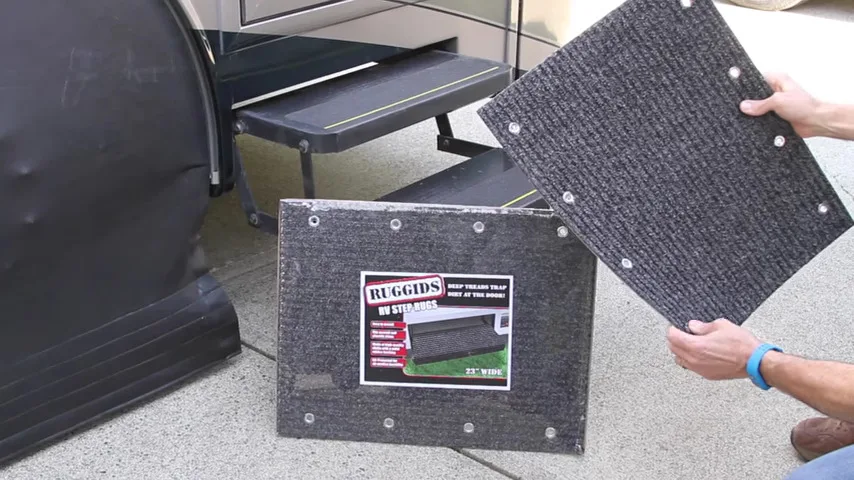
These Ruggids step covers are a cinch to install.
Once you have your Prest-O-Fit Ruggids RV step covers in hand, you’ll need only a set of wire cutters to complete the job. Four large cable ties are included with your new RV step covers.
1. Set your new step cover on your RV step evenly, front to back.
2. Feed the four cable ties through the four eyelets on the front of the step.
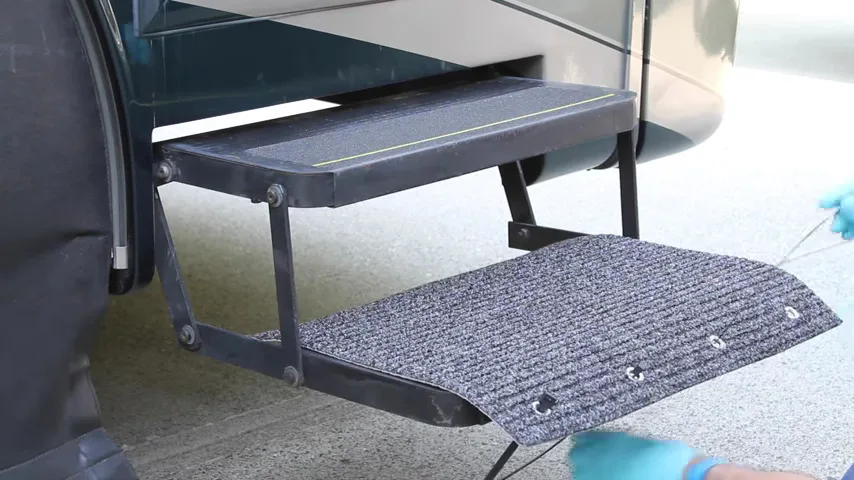
Feed the cable ties through the eyelets.
3. Feed the end of the cable ties under the step and through the eyelets in the cover at the back of the step.
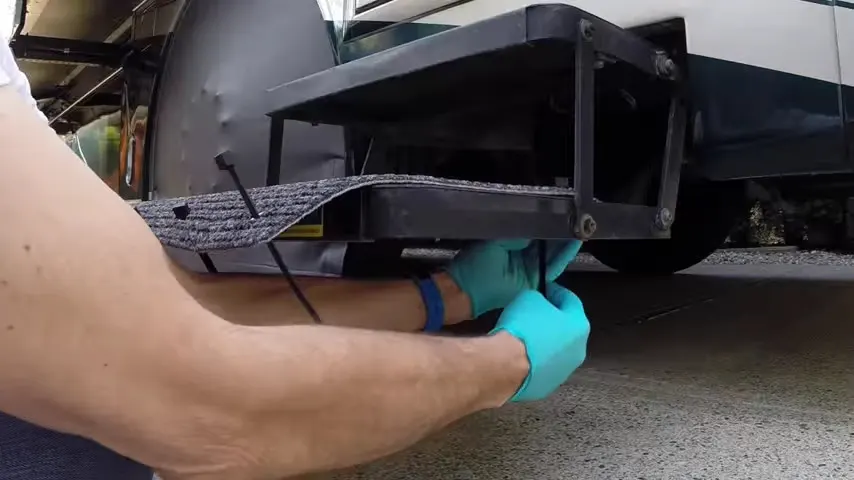
Feed the ends of the cable ties through the eyelets in the back of the step.
4. Pull the end of the cable tie back through the head of the cable tie, just as you would with any other type of zip tie. (Don’t tighten fully just yet.)
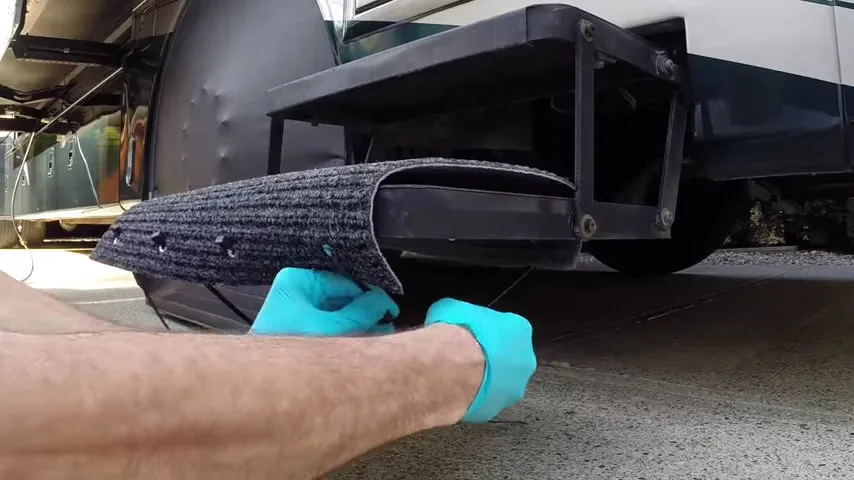
Pull the end of the cable tie through the fastener head just as you would with any other type of zip tie.
5. Repeat the process for all four eyelets and ties, and then adjust the step cover so that it’s centered properly.
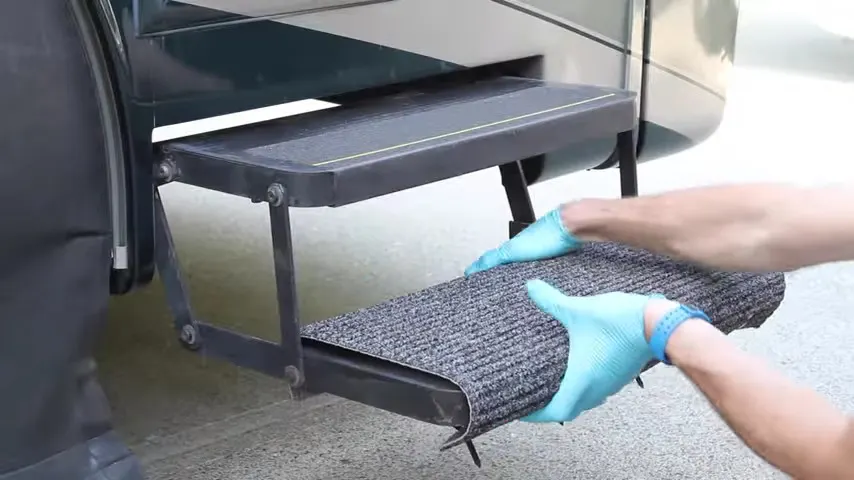
Before tightening the four cable ties, adjust the step cover so that it’s centered properly.
6. Tighten all four cable ties so that they’re taut and firmly holding your step cover in place.
7. Use your wire cutters to cut the remaining ends of the cable ties hanging beneath the step.
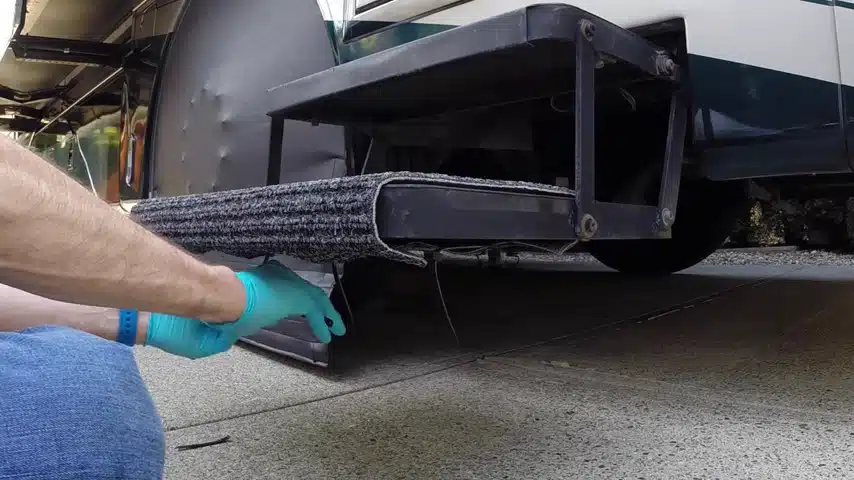
Cut the ends of the cable ties with a wire cutter.
8. Repeat the process for all of your RV steps.
Should you prefer to watch a video of us installing our own Prest-O-Fit Ruggids, we’ll leave it right here for you.
Conclusion
Even though RV step covers may not be something we think about every day, they’re absolutely something we use over and over again, day in and day out. In fact, an RV’s entryway steps are among the most used features of an RV. Their frequent use, the importance of safety going up and down the steps whether wet or dry, and their helpfulness in keeping debris out of the RV make quality step covers worth their weight in gold.
Geek Out with Us Every Week
Join our newsletter to learn about all things RV-related. Every week we offer free tips, tricks, product reviews, and more to our online community of RVers. So, whether this is your first time on the road or you’re a seasoned expert, we’d love for you to geek out with us!



Terry L
Tuesday 16th of January 2024
Do the step covers get dirty and wet when driving in rainy weather? If so, does that create a problem?
Terry L
Friday 19th of January 2024
Cool, we just bought the set you recommend and I can't wait to install them.
TheRVgeeks
Tuesday 16th of January 2024
Hi Terry! They do get somewhat wet when driving in the rain, although no wetter or dirtier than any other exterior part near the front lower part of the rig. It's no problem, as we wash/hose off the steps/step covers whenever we wash the rig. But even in between washes, it's no problem.
Steve L
Thursday 7th of October 2021
I'm sorry this not related to the subject but I was curious:
Gentlemen, hope you are all well. I bought new tires for my RV couple of years ago. They were Michelin XZE 245/R70/19.5 they are 16 ply. They replaced the same size tires that were getting on and one blew out in Texas causing damage to the exhaust and one of my compartments. My id plate which is on the inner wall next to my driver's seat says keep them at 85 PSI, the tires say 110 PSI. Which pressure should I use? The Michelins seem to be a little rougher ride at 110. Thanks and thanks so much for your info emails. Your frequency will make you run out of topics! Happy Trails ~ Steve Lamb
TheRVgeeks
Thursday 7th of October 2021
Hi Steve! First of all, very sorry to hear about the blowout and damage. Hope it wasn’t too traumatic or expensive. The short answer to your question is that neither of those pressures is correct. The pressure depends on the weight that the tire is carrying. Assuming you have not yet had your coach weighed at all four corners, run 110 until you do get it weighed at all four corners. Once you get those corner weights, you can refer to the The tire pressure inflation chart for your specific tire from Michelin. They will tell you exactly what pressure to run based on how much weight the tire is carrying. Be sure to note the difference between single and dual use, as front tires almost always require higher pressure than rear tires due to the fact that they are single, and carrying weight all alone. Whatever the recommended pressure is in the owners manual, we always recommend rounding up to the nearest five psi. One other very important factor… It’s extremely important that all tires on any given axle are at the same pressure. So one side of the RV will almost always be heavier than the other, but you must use the higher number. So if the left side front tire requires 105 pounds for its weight, and the right front tire requires 100 pounds for its weight, both tires must be said to 105. Hope this helps!
Jere
Monday 4th of October 2021
Put the new rugs over the old ones or some other cushion and the new one will last ever longer-- they won't wear on the outside edge as fast.
TheRVgeeks
Monday 4th of October 2021
That's a great idea! As long as the extra thickness doesn't interfere with the operation of the steps, definitely worth trying. Although Ruggids do take a LONG time to wear, even on the edges!
Alan
Monday 4th of October 2021
Can I assume that 23" are the widest available? My steps are 30" wide...
David Reyburn
Monday 15th of November 2021
Me too. My 2013 Mountain Aire has 30 inch wide steps, and the non-skid tread portion in 26 inches wide. Why does nobody make them that wide?
TheRVgeeks
Monday 4th of October 2021
23" are indeed the widest. It obviously won't cover the entire width of such a wide step, but centering it does provide a very good step area.
Drew
Monday 4th of October 2021
I have the ones that came with the metal springs. I like that more. The zip ties can loosen and rot. Have had mine in excess of 5 years and they're still good.
TheRVgeeks
Monday 4th of October 2021
We like the springs, too, but have only had one zip tie break in all these years. Quick fix since we keep a small hardware store's worth of parts (including large zip ties) on board! LOL